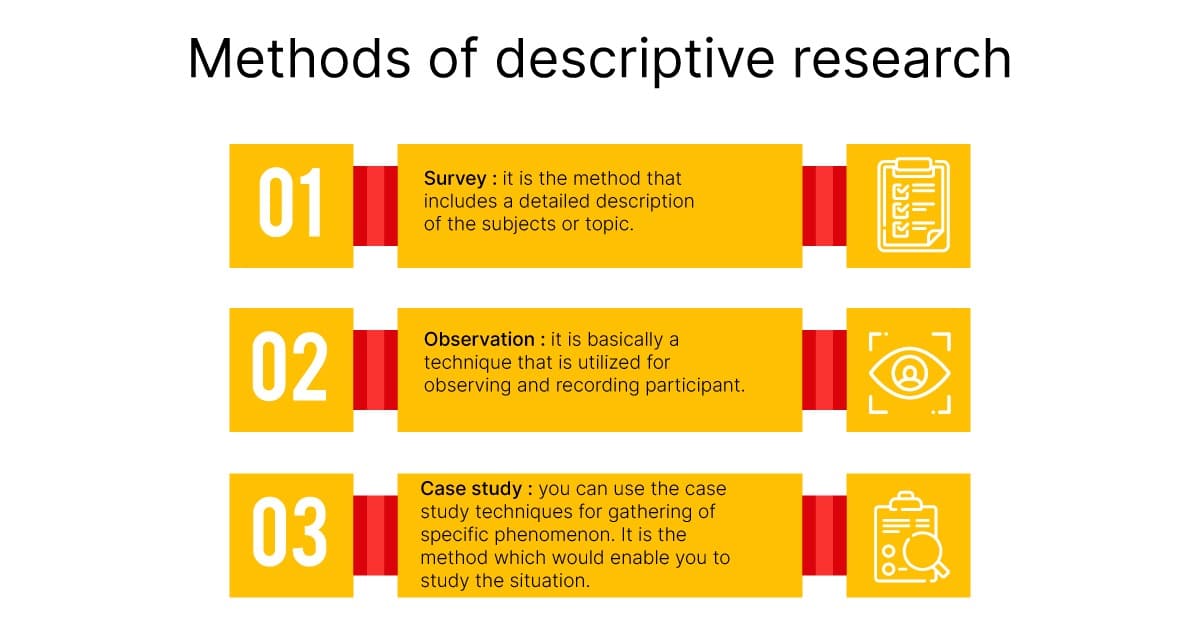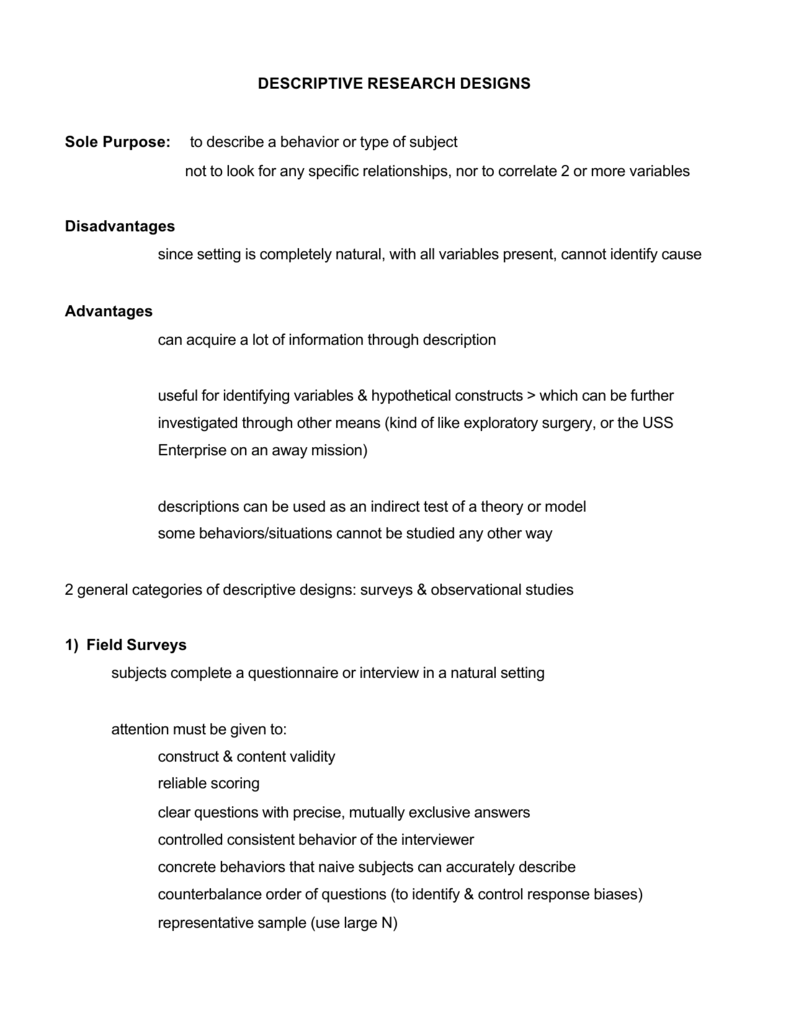Table Of Content

In this step, you must determine the tools you will employ for the data collection process. Some examples of different tools that can be used are interviews, questionnaires, observation schedules, reaction scales, etc. In this type of survey, standardized data is collected from a cross-section of the pre-determined population at a given point in time.
Descriptive research methods
Organisation of services and systems of care in paediatric spinal cord injury rehabilitation in seven countries: a survey ... - Nature.com
Organisation of services and systems of care in paediatric spinal cord injury rehabilitation in seven countries: a survey ....
Posted: Sat, 20 Nov 2021 08:00:00 GMT [source]
This is a quantitative description technique that seeks to answer questions about real-life situations. For example, a researcher researching the income of the employees in a company, and the relationship with their performance. Descriptive research focuses on providing a detailed depiction of a phenomenon, while exploratory research aims to explore and generate insights into an issue where little is known. The funder had no role in the conceptualization, design, data collection, analysis, decision to publish, or preparation of the manuscript. In this stage, you will have to identify which tools and techniques are relevant and valid to your study. Leverage robust survey software that offers you multiple channels, thus enabling you to utilize various channels to gather insights.
Cannot test or verify the research question
Automotive engineer job description targetjobs - TARGETjobs
Automotive engineer job description targetjobs.
Posted: Tue, 27 Feb 2024 08:00:00 GMT [source]
According to the Self-Determination Theory [52], relating to others by engaging in employment outside the home not only alleviates isolation but also enhances their motivation. Additionally, contributing to society as valued members of the healthcare profession enhances their self-esteem [36] and allows them to cultivate a professional identity. If their children or significant others take pride in the nursing profession, their identification with nursing becomes stronger. During the COVID-19 pandemic, nurses were portrayed as heroes combating the crisis, which enhanced their professional identity and the pride their families had in them.
Characteristics of descriptive research
Sandelowski (2000) indicated that qualitative content analysis is the approach of choice in descriptive research; however, confusion exists between content and thematic analysis, which sometimes means researchers use a combination of the two. Decisions to use one over the other will depend on the aims of the study, which will dictate the depth of analysis required. Although there is a range of analysis guidelines available, they share some characteristics and an overview of these, derived from some key texts (Sandleowski, 2010; Braun and Clark, 2006; Newell and Burnard, 2006), is presented in Table 1. Central to these guidelines is an attempt by the researcher to immerse themselves in the data and the ability to demonstrate a consistent and systematic approach to the analysis. Qualitative descriptive designs are common in nursing and healthcare research due to their inherent simplicity, flexibility and utility in diverse healthcare contexts. However, the application of descriptive research is sometimes critiqued in terms of scientific rigor.
Importance of Descriptive Research in Scientific Studies

It is often used in market research, psychology, and some other social science research to understand human behaviour. Descriptive research is a methodological approach that seeks to depict the characteristics of a phenomenon or subject under investigation. In scientific inquiry, it serves as a foundational tool for researchers aiming to observe, record, and analyze the intricate details of a particular topic.
By adding to the existing knowledge base, this paper enhances the information available to researchers who wish to use the qualitative descriptive approach, thus influencing the standard in how this approach is employed in healthcare research. As seen in our paper, qualitative descriptive studies have a role in healthcare research providing insight into service users and providers’ perceptions and experiences of a particular phenomenon, which can inform healthcare service provision. Focus group interviews are a common data collection method in qualitative descriptive studies and were the method of choice in a study by Pelentsov et al. (2015), which sought to identify the supportive care needs of parents whose child has a rare disease. The rationale provided for using a qualitative descriptive design was to obtain a ‘straight description of the phenomena’ and to provide analysis and interpretation of the findings that remained data-near and representative of the responses of participants.
About this article
In this study, four semi-structured focus group interviews were conducted with 23 parents. The data from these focus groups were then subjected to a form of thematic analysis during which emerging theories and inferences were identified and organised into a series of thematic networks and ultimately into three global themes. These themes identified that a number of factors including social isolation and lack of knowledge on behalf of healthcare professionals significantly affected how supported parents felt. Identifying key areas of the supportive needs of parents using qualitative description provides direction to health professionals on how best to respond to and support parents of children with a rare disease.
Examples of descriptive
This means you're free to copy, share and adapt any parts (or all) of the text in the article, as long as you give appropriate credit and provide a link/reference to this page. Because there are no variables manipulated, there is no way to statistically analyze the results. The results from a descriptive research can in no way be used as a definitive answer or to disprove a hypothesis but, if the limitations are understood, they can still be a useful tool in many areas of scientific research. For example, a business looking to sell to its target market should research the market’s behavior first.
Study designs: Part 2 – Descriptive studies
It involves open-ended interviews, observations, or small-scale surveys to gather qualitative data. The importance of descriptive research lies in its ability to provide a glimpse of the current state of a phenomenon, offering valuable insights and establishing a basic understanding. Further, the advantages of descriptive research include its capacity to offer a straightforward depiction of a situation or phenomenon, facilitate the identification of patterns or trends, and serve as a useful starting point for more in-depth investigations. Additionally, descriptive research can contribute to the development of hypotheses and guide the formulation of research questions for subsequent studies. Regarded as a positive aspect by many researchers who are interested in studying human nature and phenomenon, others believe this flexibility leads to inconsistency across studies and in some cases complacency by researchers. This can result in vague or unexplained decision making around the research process and subsequent lack of credibility.
This type of research provides a detailed and accurate picture of the characteristics and behaviors of a particular population or subject. By observing and collecting data on a given topic, descriptive research helps researchers gain a deeper understanding of a specific issue and provides valuable insights that can inform future studies. Ensuring credibility, confirmability, transferability and dependability contributes to the trustworthiness of the study [42].
Online data collection also offers the opportunity to collect synchronous and asynchronous data using instant messaging and other online media (Hooley et al., 2011). Online interviews or focus groups conducted via Skype or other media may overcome some of the limitations of telephone interviews, although observation of non-verbal communication may be more difficult to achieve (Janghorban et al., 2014). Purposive sampling refers to selecting research participants that can speak to the research aims and who have knowledge and experience of the phenomenon under scrutiny (Ritchie et al., 2014). In addition, the heterogeneity of the population will need to be considered and how this might influence sampling and subsequent data collection and analysis (Palinkas et al., 2015). Take, for example, conducting research on the experience of caring for people with Alzheimer’s disease (AD).
The measurement bias in this study would relate to the accuracy of measurement and the cutoff used. If the investigators had used a cutoff of −0.25 D (instead of −0.50 D) to define myopia, the prevalence would have been higher. Furthermore, if the measurements were not done accurately, some cases with myopia could have been missed, or vice versa, affecting the study results. This involves an in-depth examination of a single individual, group, or situation to gain a detailed understanding of its characteristics or dynamics.
Sample size will also need to be considered and although small sample sizes are common in qualitative descriptive research, researchers need to be careful they have enough data collected to meet the study aims (Ritchie et al., 2014). Pre-determining the sample size prior to data collection may stifle the analytic process, resulting in too much or too little data. Traditionally, the gold standard for sample size in qualitative research is data saturation, which differs depending on the research design and the size of the population (Fusch and Ness, 2015). Data saturation is reached ‘when there is enough information to replicate the study, when the ability to obtain additional new information has been attained, and when further coding is no longer feasible’ (Fusch and Ness, 2015, p. 1408). However, some argue that although saturation is often reported, it is rarely demonstrated in qualitative descriptive research reports (Caelli et al., 2003; Malterud et al., 2016). If data saturation is used to determine sample size, it is suggested that greater emphasis be placed on demonstrating how saturation was reached and at what level to provide more credibility to sample sizes (Caelli et al., 2003).
No comments:
Post a Comment